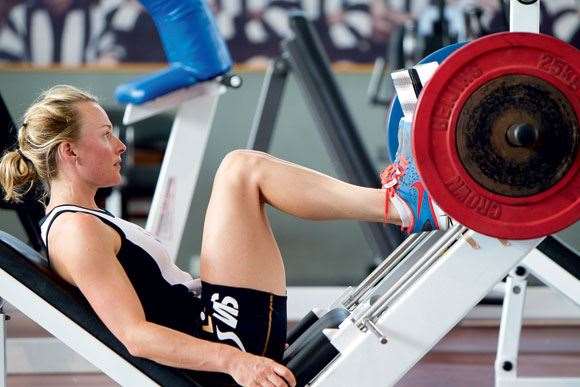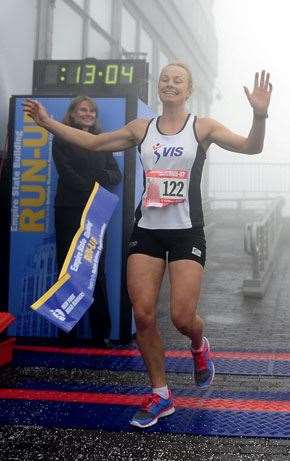Hands up those who ran to beat the closing lift doors on their way up to their fifth-floor office suite this morning?
Hands up those who ran to beat the closing lift doors on their way up to their fifth-floor office suite this morning? There was no such luxury for Australia’s Alice McNamara when she landed in New York to tackle the 34th annual Empire State Building Run-Up. We’re talking 86 floors of hell; 1576 stairs which send competitors 300m above Manhattan’s famous skyscraper-dominated cityscape.
Aussies have made a habit of shaming the Yanks at their 1931-opened national monument of late, with McNamara following in the up-steps of Suzanne Walsham, who scored a pair of wins in 2007 and ’08. The race’s record, 9 mins, 33 seconds, set in 2003, is owned by an Aussie as well, professional cyclist Paul Crake. Here, McNamara fills Inside Sportin on how her punishing rowing training regime took her to the top – literally – of the world’s stair-climbing community.
STEPPING UP
“I’d never been to the States before the Empire State Building Run-Up. I was entered into the Eureka Tower climb with the rowing squad from the Victorian Institute of Sport last November to support the charity Whitelion, who focus on youth justice. The marketing people at the VIS had a team of four they needed to fill and one of the girls thought we rowers would do a good job of that. She entered four of us into the Eureka time trial team event and we won it! Initially the officials awarded the New York trip prize to a runner from Melbourne, but her time was 10 minutes, 49 seconds; my time was 10.24. So they rang me back and said ‘your time in the team event was quicker than the girl who ‘won’, so we’ll have to ring her and tell her she didn’t get the prize’ – which was five nights in New York and flights supplied by Travel Scene.
“I decided to try to enter the Empire State Building Run-Up. I applied to the New York Road Runners; they have a committee that determines who gets a start. I had to provide my sporting history to them, telling them if I was of a track and field persuasion or not. I had to tell them in 25 words or less why I thought I should be able to start. I told them I was a world-level rower from Australia in the lightweight women’s doubles, a two-time world champion in the lightweight women’s quads, that I placed fourth last year at the World Championships and that I won a World Cup in Lucerne last year in the lightweight doubles. I also told them, ‘After my first stair climb up the Eureka Tower, I loved it and my dream now is to run up the Empire State Building in New York.’”
 The new face of stair climbing? Images: Joseph Feil
The new face of stair climbing? Images: Joseph FeilWELL-PREPARED
“Even though I don’t have a running background, stair climbing places high demands on your quads and glutes. So, if you’ve done cycling and rowing, which are predominately leg-based, you’ve probably set up your legs pretty well to tolerate that lactic. With almost seven years of full-time rowing under my belt, I thought, ‘ C’mon, you’ve got to back yourself half-way up that you’ve done all this before.’
“Rowing in the lightweight class, we have to average 57kg in the doubles. So we have weight management requirements. Rowing-specific training is only one aspect of my regime. On top of that, I do a little bit of running or extra commuting on my bike for my weight management. You end up being quite efficient in the power-to-weight stakes.”
ROWING VS STAIR CLIMBING
“In rowing, we have a lot of measurable training. We do a lot on the ergometer [indoor rower] and a lot on the Wattbike. Quite often you have splits and times
and distances and stroke rates you know you should be able to maintain.
“Stair-climbing, on the other hand, is an activity you can apply yourself to maximally, but you have no idea of your capabilities or limits or maximums. We spend a lot of time in rowing on the technical aspects as well. With stair climbing, it’s just ‘go for it and race’.”
ROW, ROW …
“We train between 20-30 hours per week for most of the year; it’s a fairly full-time training load. We do six or seven on-the-water sessions, two long bike rides, three gym and two ergometer sessions each week. Then there’s the Wattbike, which is mixed in as another training session.”
WATT?
“The Wattbike simulates riding a bike on the road; each pedal stroke you take has a bit of run to it. The Wattbike has a computer screen which displays a graph with four quadrants. It records your forward and back pedal strokes; you can see your left and right-foot force application, so you can sit evenly on the bike, pushing equally with both legs. You can see your power output in watts or kilometres per hour. Your cadence and resistance are settable, allowing you to predict the outcome of your watts generated by the end of your session.”
 All that rowing training paid off for Alice McNamara. Images: Joseph Feil
All that rowing training paid off for Alice McNamara. Images: Joseph FeilERGO-NOMICAL
“The ergometer is the rowing machine. We call it the ‘ergo’. You’ve probably seen it in gyms, but we tend to do sessions on it: 15-minute pieces or 20-minute blocks. The ergometer has set ratings or speeds which you’re meant to sit on.
“My coach at the VIS, Bill Tait, sent me a text message the night before the Empire State Building race saying, ‘Remember when you get to level 40, that lactic is so familiar and you love it.’ It’s true – our racing in rowing is over seven-to-eight minutes for lightweight scullers, so we train for seven-minute races, but a lot of the work we do is for 15-20-minute peaks on the water and on the ergo. We’re used to tolerating a high amount of lactic for about the time it takes to win the Empire State race.”
IN THE GYM
“We stick to mainly strength-based training in the gym for most of the year. For me, my strength weight sessions consist of four exercises – squats, powercleans, benchpulls and benchpresses. There’ll predominately be four-five sets of five-eight reps. We try and build muscle strength without adding bulk. My strength coach at the VIS, Harry Brennan, will throw in counter-sets, where, if I do squats, I’ll follow with box jumps, or single-leg explosive leg drives onto the box. So you might be on one leg and you’ll drive your other knee up and come up jumping.”
AND THEY’RE OFF
“Everyone who’s raced the Empire State Building Run-Up in the past is seeded. I was actually 22. The top ten are placed at the front, meaning I started in the middle of the second row. As they were marshalling people, because I had watched the Youtube video from the year before, I saw the chaos at the start and thought, ‘I’ve got to get to the stairwell so I don’t have to wait at the bottom while everybody sorts themselves out; there’s a risk of falling behind two flights of stairs.’ I thought, ‘I’m going to edge myself to the side, so I can be in the second row, but then edge my way almost to the first row.’ As the gun went off, I was gone!”
IN THE STAIRWELL
“You’re working at a high level aerobically; probably 85 per cent intensity. Everyone is going at a pretty quick pace. You have to make one big swift move to go around someone. You can’t just sit next to them and pace yourself; you’d be covering extra distance from going around the outside of the stairwell. What I did was make a bee-line for an Aussie girl at the start who had won the race a few years before. I thought, ‘I’ll sit behind her for a few levels and just go with the pace.’ There were two girls in front of her, so we were probably sitting about third and fourth, or fourth and fifth. They were edging away, and I thought, ‘I’m going to have to make a move around the Aussie girl or I’m going to lose contact with the girls in front.’ This was probably in the first 20 levels.
“On the landings the runners had a bit of an advantage, but I backed myself on the stairs. I just did a sprint, two stairs at a time, to lunge around the Aussie, then quickened my pace up towards the next girl. Then I sat behind her for a couple of levels. At about level 30 I ran around her. Around about 36-37, I passed another girl. I put my head down and lunged past her.
“When I got to half-way, I wasn’t sure whether I was in the lead. I thought there might have been one girl still ahead of me. I didn’t know until ten floors to go, when one of the marshals said, ‘You’re coming first in your category,’ so I kind of knew I was in the lead from then. From about half-way on, I just had to ‘rhythm’ it.”
 Winner Images: Joseph Feil
Winner Images: Joseph FeilBIT DUSTY
“The Empire State Building is an older stairwell; it’s narrow, but seems to have high ceilings, so it doesn’t feel as claustrophobic. It’s dusty in there, though. When I finished the race, my legs and glutes were tired, but it was mainly my lungs ... I had that feeling in the back of my throat like an iron or blood-like taste, because I absolutely burnt myself. I was coughing up dusty, mucusy stuff. It really hits your lungs quite hard. I imagine the building doesn’t get aired out very often; obviously everyone uses the lifts. Some of the doors were open at each level, but it probably doesn’t have as much airflow as it could. Outside, it was sleeting and snowing, so it was actually a bit of a relief to be somewhere a bit cold at the finish.”
CUTTING CORNERS
“My technique was two stairs at a time, then grab the end of the banister and with two arms, swing myself around the corner so I didn’t have to do so much running on the flat landings. At the end of the race the lats on my right-hand side ‒ because I was grabbing the banister and swinging myself around the corner ‒ were a little bit sore, but that was fine. In rowing we use our lats and arms a lot more than runners do.
“I think the margin I won by was about a minute. Racing is easier when you’re out on your own. Towards the top I was maxing-out. I was absolutely spent, but I went really hard early and had no idea of the capacity of the race or my capacity in the context of the race.”
STAIR MESSIAH
“I’ve had a couple of stair climbers email me or Facebook me since the win asking for training advice. It would be the ideal cross-training method for rowing. If you were honest about it, you’d head to the Eureka Tower and do three reps of those stairs ‒ three 12-minute bursts.
“It’s a new world I’ve been exposed to. Some people follow these climbs around the world. I’ve since heard of a few other events, like the Sydney Tower run in July, which I actually think I’ll be overseas for with rowing, but I’d love to do that. That’s probably one of the biggest stair climbs in Australia.”
GAIN FOR PAIN
“Stair climbing is much better in the gain for pain stakes compared to rowing. The amount of interest that’s come out of this competition compared to wins I’ve been involved with in rowing is amazing.”
MANHATTAN DASH
“My flight out of New York left at 4pm. The race finished at 11am. I needed to do some media after the race, then get a trophy, then get back to my hotel by 12.15pm. It was snowing, so the trains were down. So I actually ran from the Empire State Building after the competition, through the snowy streets of Manhattan, down Fifth Avenue, past Gucci, past Prada, in my tracksuit, with a trophy in my hand and just made the shuttle bus to the airport!”
– James Smith
Related Articles

Magnificent seven? Scheffler plays down career slam

Allan goes wire-to-wire for second Champions Tour win













